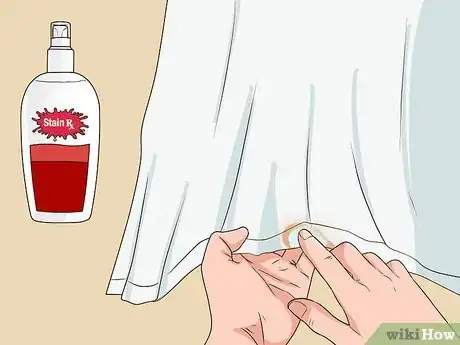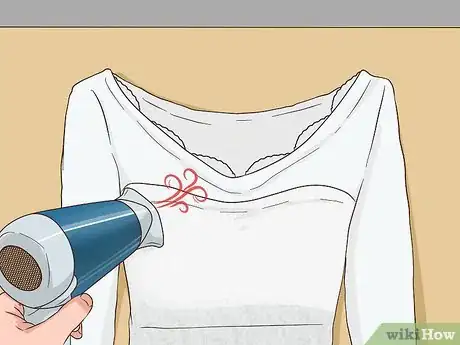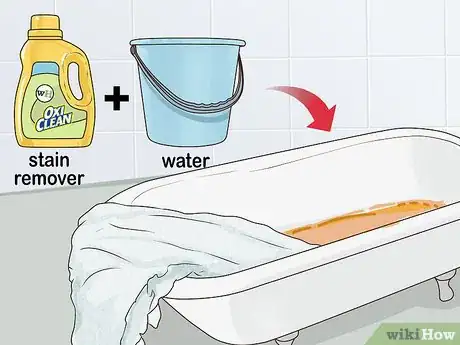This article was co-authored by Karen Brown. Karen Brown is the Founder and Creative Director of Karen Brown New York, a full service event planning company. Karen has planned hundreds of successful weddings, corporate parties, award ceremonies, product launches, galas, and fundraisers over the past decade throughout the United States, Mexico, and Canada.
wikiHow marks an article as reader-approved once it receives enough positive feedback. In this case, 93% of readers who voted found the article helpful, earning it our reader-approved status.
This article has been viewed 491,462 times.
Your wedding is a day for creating memories, so you'll definitely want to preserve your wedding dress. You can easily hand-wash the gown on your own if your bridal gown fabric and lining are polyester. Dry-cleaning solvents don't remove perspiration and most food spills, so wet cleaning will often clean your gown better than dry-cleaning.
Steps
Spot-Treating Stains
-
1Perform a thorough inspection of your dress. Look over the dress for any stains, taking into account what the stain consists of. Make sure you have the cleaning supplies you will need.
- Take a good look at the hemline. Unless you lifted your skirt and carried your train everywhere you went on your wedding day, your train will be dirty. Wedding dress trains are like great big dry mops that clean the floors of churches and reception centers!
- Inspect the different layers. Wedding dresses can consist of more than one layer of fabric, so it's a good idea to look over each layer for any stains. Inspecting every element of your dress will help you recognize what needs to be cleaned so you can plan accordingly.
-
2Test the spot cleaner. Use a heavy stain remover (e.g., Stain RX) as soon as possible, but before you use it on your wedding gown, be sure to test it on a small area to ensure it doesn't ruin the fabric. Pick out a spot that is not noticeable and test it on that area.[1]Advertisement
-
3Separate your layers with a paper towel. While cleaning a stain on one layer, place a piece of paper towel underneath so the stain doesn't transfer to that layer. The paper towel should absorb the stain so it doesn't transfer onto another part of your dress.[2]
-
4Pat the stain out with the stain remover. Don't rub the stain remover into the dress because your dress is fragile and may tear. Instead, apply the stain remover then use a wet towel to gently push away from the stain. Apply this method to the edges of the stain.[3]
-
5Dry your dress. Use a hair dryer to dry the water off the dress. Leaving it to air dry may create water rings in the dress.
Washing the Dress
-
1Soak the dirty hem in a bathtub. Keep the body of the dress out of the water while following this step. Make sure the bathtub is clean and use warm, sudsy water to soak your hem for a couple of hours.
- Working your way around the dress, use a toothbrush and the liquid detergent to "massage" the hemline clean. Be careful not to scrub too vigorously on lace or trims, and clean the underside of the hem and dress lining, as well.
- Rinse the hem thoroughly when you are finished cleaning it.
-
2Clean the bodice. Turn the dress bodice inside out, and spray the lining of the bodice area (the part that fits on your upper body) with a dish soap and water solution. Use the toothbrush and the detergent to clean perspiration stains that may appear in the underarm area.
-
3Clean the separate layers. If your dress has many layers of lining in the skirt, be sure to look over all of them and clean all the stains you find with a spot-cleaner. This is where inspecting every area of the dress comes in handy.
-
4Spot clean the outer layer. Spray any stains on the outside of your dress with your spray solution using the toothbrush if necessary. Be very gentle and carefully blot the fabric. Be particularly careful of laces and trims.
-
5Try a stronger stain remover. If soap and water do not remove the stains, mix up a solution of a stain remover, such as OxyClean®, and water. Place the stained area in the solution to soak until the stain disappears. Do not use chlorine bleach, such as Clorox, as it leaves a film that is very difficult to remove.
-
6Rinse your dress. When you are satisfied with the cleaning of your dress, fill the bathtub with warm water and place the whole dress carefully in the tub. Swish the dress around in the water as soaps from the cleaning process are rinsed out. Let the water drain and then fill the tub again and repeat the process.
- Follow this procedure several times until the water is very clear without any soap bubbles. It is critical to get all soap and cleaning solutions rinsed out of the dress to avoid potential damage from chemicals.
-
7Dry your gown. The dress should be "line" dried, but not by hanging it on a hanger because the weight of the wet dress could damage it. Line dry it safely by placing a fold-up drying rack (vinyl coated) in the bathtub and hanging the dress over it.
- Place the dress so the weight is equally distributed over the rack.
- You can also place a clean towel over a shower enclosure, and then place the dress over the towel. If you do this, be sure to place some towels on the floor underneath the dripping dress to protect the floor.
- Do not place the dress on bare wood.
-
8Hang your dress after it's dry. After the dress has dried for several hours and the bulk of the water has dripped away, it may be possible to hang the dress to finish drying it. Carefully spread any layers of tulle in the skirt or lining and smooth out all wrinkles in the dress as much as possible. This will make the pressing process easier.
Preserving Your Gown
-
1Protect your work area. Spread a clean sheet on the floor of your working area to protect the dress as you press it. It is best if you use a clean press cloth of white cotton sheeting or muslin unless you are using a brand new or freshly cleaned iron.
-
2Press it. Start at the back and bottom of the train until you feel comfortable with the pressing. Take your time and use caution. When it is finished you are ready to preserve your gown. We recommend that you first wash and dry your ironing board cover to remove any dirt, starch, or sizing.
- Where possible, press the dress from the inside. If you have a thick, cushy, ironing board cover, the sequins and beads can press into it. Start at a low temperature, and increase it gradually. If it starts to stick, reduce the heat immediately.
-
3Store your dress. Loosely fold your wedding gown before storing it, and store it away from sunlight because direct sunlight will cause it to yellow. Protect it from light in an acid-free chest covering it in acid-free tissue paper. Don't store the dress in plastic or hang it up.
-
4Store the box. Put your box in your closet or under your bed away from the light and far from any areas with mold or mildew. Now you can take it out and admire it whenever you want to look back on your wedding day.[4]
Expert Q&A
-
QuestionCan I clean my wedding dress at home?
 Karen BrownKaren Brown is the Founder and Creative Director of Karen Brown New York, a full service event planning company. Karen has planned hundreds of successful weddings, corporate parties, award ceremonies, product launches, galas, and fundraisers over the past decade throughout the United States, Mexico, and Canada.
Karen BrownKaren Brown is the Founder and Creative Director of Karen Brown New York, a full service event planning company. Karen has planned hundreds of successful weddings, corporate parties, award ceremonies, product launches, galas, and fundraisers over the past decade throughout the United States, Mexico, and Canada.
Wedding & Event Planner Possibly, yes. Typically, the shop where you buy your dress will give you instructions on how to clean it. Some may even offer a one-time cleaning service after your wedding.
Possibly, yes. Typically, the shop where you buy your dress will give you instructions on how to clean it. Some may even offer a one-time cleaning service after your wedding. -
QuestionCan a 100% nylon 1970s wedding dress safely be washed in a washer even if the label says dry clean only?
 Community AnswerI would dry clean it or hand wash it to be on the safe side.
Community AnswerI would dry clean it or hand wash it to be on the safe side. -
QuestionHow do I remove a mud stain?
 Community AnswerLet the mud stain dry. Brush the spot to remove any soil. Soak the dress in a solution of 1 quart of warm water, 1 teaspoon of liquid dish detergent and 1 tablespoon of white vinegar for 15 minutes. Rinse with water.
Community AnswerLet the mud stain dry. Brush the spot to remove any soil. Soak the dress in a solution of 1 quart of warm water, 1 teaspoon of liquid dish detergent and 1 tablespoon of white vinegar for 15 minutes. Rinse with water.
Warnings
- Professional dry-cleaning is recommended for silk fabrics. Silks can be wet cleaned but require experienced cleaners as silk damages easily.⧼thumbs_response⧽
Things You'll Need
- 1 toothbrush
- Spray bottle filled with warm, sudsy soap and water
- Oxy Clean® for juice, jam or wine stains
- Optional: Carbona® Stain Devils for rust and other stains (available at drug & discount stores).
References
About This Article
To clean a wedding gown, start by hanging or draping the hem into a bathtub full of warm, sudsy water. If the hem is particularly dirty, use a toothbrush and liquid detergent to gently scrub the hemline clean. In order to clean the bodice, turn the material inside out, spray the lining with a dish soap and water solution, and use a toothbrush to work the solution into the material. You can then spot clean the skirt by spraying soap and water on the affected areas. When the dress is clean, soak it in warm water to remove all soap and detergents before air drying it. To learn how to properly store a wedding gown, keep reading!












































































